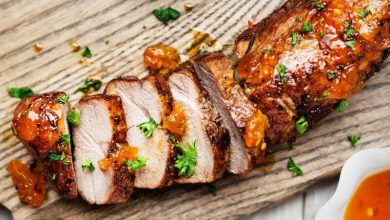🍊🧀🍞 Apricot Orange Stuffing/Dressing 🍞🧀🍊
What is it?
Apricot Orange Stuffing/Dressing is a delightful and flavorful side dish often served during Thanksgiving and other festive occasions. It combines the sweet and tangy flavors of apricots and oranges with the comforting textures of bread and other ingredients to create a delicious stuffing that complements roasted poultry or can be enjoyed as a standalone dish.
History:
The history of this dish can be traced back to traditional stuffing recipes, which have been prepared for centuries in various cultures. Stuffing or dressing was originally created as a way to make use of leftover bread and ingredients. Over time, creative cooks began adding fruits, herbs, and other ingredients to enhance the flavor. The combination of apricots and oranges likely emerged from a desire to add a touch of sweetness and citrusy brightness to the dish.
Components:
- Bread: Typically, white or whole wheat bread is used, cubed or torn into pieces.
- Apricots: Dried apricots are a key ingredient, providing sweetness and a chewy texture. They are often chopped or diced.
- Oranges: Orange zest and juice are used to infuse the stuffing with citrusy notes.
- Herbs: Fresh herbs like thyme, sage, and parsley can be added for flavor.
- Onions and Celery: These vegetables are sautéed to create a flavorful base.
- Butter or Oil: Used for sautéing and to add richness.
- Chicken or Vegetable Broth: For moisture and to bind the ingredients.
- Seasonings: Salt, pepper, and possibly other seasonings like nutmeg or cinnamon.
- Nuts: Optional, but chopped pecans or almonds can add a crunchy element.
Steps to Prepare:
- Preparation: Preheat your oven to 350°F (175°C). Prepare a baking dish.
- Bread: Place the cubed or torn bread in a large bowl.
- Fruit: Chop the dried apricots and add them to the bread. Zest and juice an orange, adding both to the mixture.
- Sauté: In a skillet, melt butter or heat oil over medium heat. Sauté chopped onions and celery until they are soft and fragrant.
- Herbs and Seasoning: Add fresh herbs, salt, and pepper to the skillet. Cook briefly to release their flavors.
- Combine: Pour the sautéed mixture over the bread and fruit. Mix everything together until well combined.
- Broth: Gradually pour chicken or vegetable broth over the mixture, stirring as you go, until the stuffing reaches your desired level of moisture. Be careful not to make it too wet.
- Bake: Transfer the stuffing into the prepared baking dish and cover it with foil. Bake for about 30-40 minutes. Uncover and bake for an additional 10-15 minutes to achieve a crispy top.
- Serve: Once the stuffing is golden brown and heated through, remove it from the oven and let it cool slightly before serving.
Time Needed:
Preparation and cooking time for Apricot Orange Stuffing/Dressing can vary, but typically it takes approximately 1 hour from start to finish, including prep time, baking, and cooling. Please note that actual times may vary depending on your recipe and oven.
Enjoy your delightful Apricot Orange Stuffing/Dressing! 🍊🧀🍞
Certainly! Here are some nutrition facts and health information for Apricot Orange Stuffing/Dressing:
Nutrition Facts (Approximate Values per Serving):
- Calories: 250-350 calories
- Total Fat: 10-15 grams
- Saturated Fat: 4-6 grams
- Cholesterol: 15-20 milligrams
- Sodium: 400-600 milligrams
- Total Carbohydrates: 35-45 grams
- Dietary Fiber: 3-5 grams
- Sugars: 10-15 grams
- Protein: 5-8 grams
- Vitamin C: 10-20% of daily recommended intake
- Vitamin A: 5-10% of daily recommended intake
Health Information:
-
Moderate Calories: Apricot Orange Stuffing/Dressing is moderately calorie-dense due to ingredients like bread and butter/oil. Portion control is essential if you’re watching your calorie intake.
-
Moderate Fat: The fat content primarily comes from butter or oil used for sautéing and flavor. You can opt for healthier fats if desired.
-
Good Fiber: The dish contains a decent amount of dietary fiber, which can aid digestion and help you feel full.
-
Added Sugars: Dried apricots and orange juice can contribute to added sugars. While some sweetness is natural and desirable, be mindful of overindulgence, especially if you have dietary restrictions.
-
Vitamins and Minerals: The stuffing/dressing provides a modest amount of vitamin C (from oranges) and vitamin A (from dried apricots). It also contains various minerals from the ingredients used.
-
Customization: You can make this dish healthier by choosing whole-grain bread, reducing butter or using olive oil, and adding more vegetables like carrots or bell peppers for added nutrients.
-
Allergens: Be aware of potential allergens in the ingredients, such as gluten in bread and nuts if you choose to add them.
Remember that specific nutritional values can vary based on the recipe and portion size. It’s always a good idea to calculate precise nutritional information if you have specific dietary concerns or restrictions. Enjoy this dish in moderation as part of a balanced meal! 🍊🧀🍞



